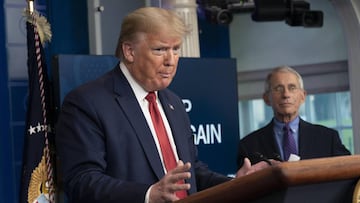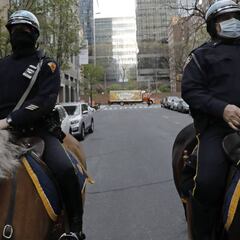Coronavirus: Trump's three-phase plan to reopen US economy
Donald Trump has announced a layered plan to reopen the US for business during the Covid-19 pandemic, but ultimate decisions lie with individual states.

The White House has released a set of guidelines for reopening the US economy in line with President Donald Trump's desire to bring an end to the national lockdown in the country due to the coronavirus pandemic. These consist of a three-phase plan that could allow some states to begin easing lockdown restrictions put in place due to Covid-19 as early as this month.
"All of American society is engaged and mobilized in the war against the invisible enemy. While we must remain vigilant, it is clear that our aggressive strategy is working," the US President was quited as a saying in a White House briefing statement released on Thursday.
Trump has been pushing for the US economy to be reopened as jobless claims soared by 22 million in the US over the past month. The Trump administration has launched a stimulus package to help US households in need with the IRS suspending the 2020 tax return deadlines and providing $1,200 checks to be dispatched over the course of the next few months. Additionally, the US government will provide $2,400 for married couples and an extra $500 per child.
Follow all the latest news related to the coronavirus crisis with our daily feed.
Trump: "America wants to be open again"
In Phase One:
— The White House 45 Archived (@WhiteHouse45) April 17, 2020
Schools that are currently closed should stay closed.
Visits to senior living facilities and hospitals should be prohibited.
Gyms can open with strict physical distancing protocols in place.
Elective surgeries can resume.
MORE: https://t.co/gdCIY9wJP8 pic.twitter.com/oIBUxOSQQ6
While some of the worst-hit states have extended their lockdowns, Trump said on Thursday that the ultimate goal is to get the country up and running again: "America wants to be open and Americans want to be open," the president said at his daily briefing. "A national shutdown is not a sustainable long-term solution."
Trump added that the final word on how and when to open each state would ultimately lie with state governors and would be dependent on a series of measures.
"We want to open up, but we want to open up safely knowing that if we do it too fast, without the appropriate strategies, it will just lead to a potential closure because of another outbreak of COVID-19," The Governor of Texas, Greg Abbott, said earlier this week.
In the first phase of Trump's guidelines, larger venues like restaurants and movie theaters could operate again with strict social distancing, according to Reuters. Non-essential travel could resume and schools could open their doors again in phase two. In phase three medically vulnerable people could resume public interactions.
The New York Times reported that Trump told governors of states that some could re-open their states by May 1 or earlier. He was also expected to soon announce hiring plans for tracking the disease's spread, according to the Times.
“We are not opening all at once, but one careful step at a time,” Trump said on Thursday. “Some states will be able to open up sooner than others. Some states are not in the kind of trouble that others are in. Now that we have passed the peak in new cases, we are starting our life again. We are starting rejuvenation of our economy again in a safe and structured and very responsible fashion.“
“Every state is very different,” he continued. “They are all beautiful. We love them all but they are very, very different. If they need to remain closed, we will allow them to do that. And if they believe it's time to reopen, we will provide them the freedom and guidance to accomplish that task and very, very quickly, depending on what they want to do.“
Trump's plan to reopen the US economy in brief
1. States should have a "downward trajectory" of Covid-19 cases for a 14-day period before reopening, or a downward trajectory of positive tests for the same time period, given flat or increasing testing levels.
2. US states have core responsibility for testing and tracing citizens. A list of "core state preparedness responsibilities" includes the "ability to quickly set up safe and efficient screening and testing sites" and ensure "surveillance sites are screening for asymptomatic cases" and Covid-19 positive people are traced.
US testing to date has been delayed and chaotic, thanks to federal government roadblocks and failures. Alphabet's Google and Apple Inc are working together on software to make contact tracing easier, but that will not be available until mid-May.
3. Phase 1 of the reopening recommends that schools and daycare facilities remain closed and that people maintain social distancing in public. Businesses should continue to encourage teleworking, and meetings of more than 10 people should be discouraged.
Event spaces like movie theaters can reopen, with "strict" social distancing measures in place. Elective surgeries can resume, on an outpatient basis. Non-essential travel and visits to senior living facilities should remain suspended. Gyms can reopen, with proper sanitation and distances, but bars should not.
4. Phase 2 of the plan, which states should progress to after another 14-day decline in positive cases, includes lifting the ban on non-essential travel. It recommends businesses continue to encourage teleworking and close common areas where people congregate.
Employers should consider special accommodation for personnel who are members of a "vulnerable population," which is defined as the elderly or people with underlying conditions like obesity, asthma and chronic lung conditions.
Schools and youth activities can resume, and bars can reopen with minimized standing room areas. Large venues, like sporting arenas and houses of worship, can operate under "moderate" physical distancing. Elective surgeries on an in-patient business can resume.
Related stories
5. Phase 3 of the plan, which states can enter after another 14-day period of declining cases, allows businesses to resume "unrestricted staffing" of worksites, and visits to senior homes to resume.
Large venues can operate with limited physical distancing guidelines and bars can increase standing-room-only areas.

